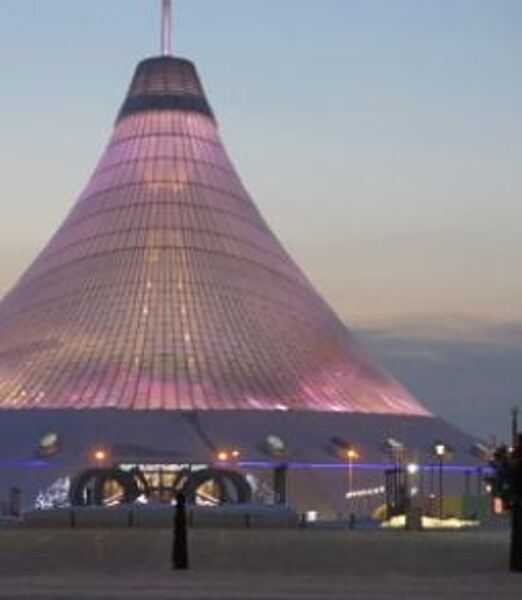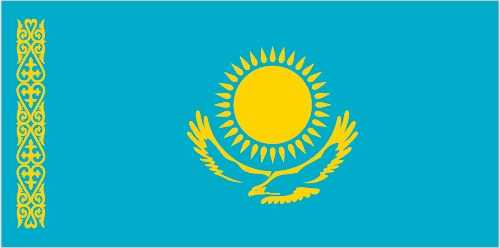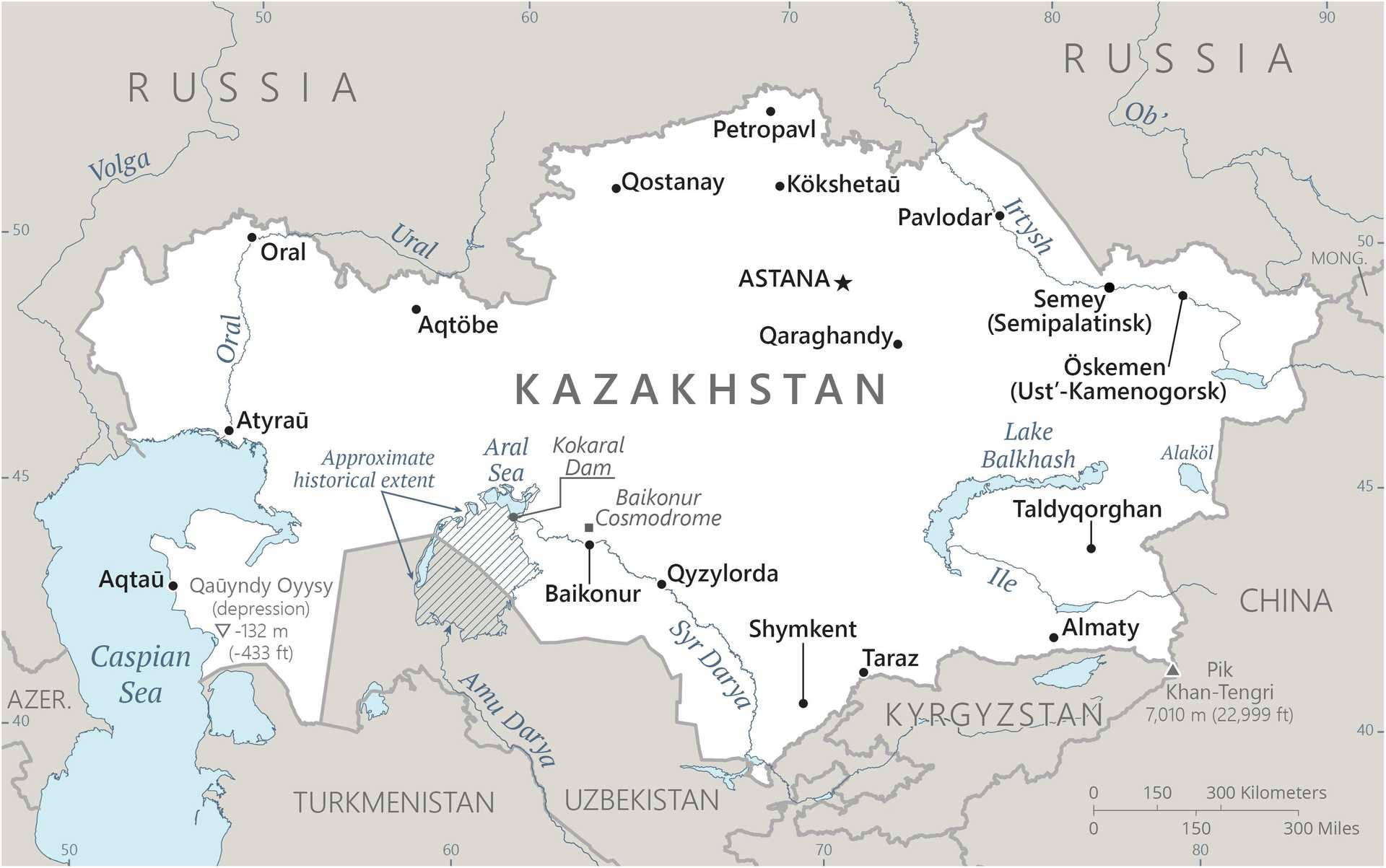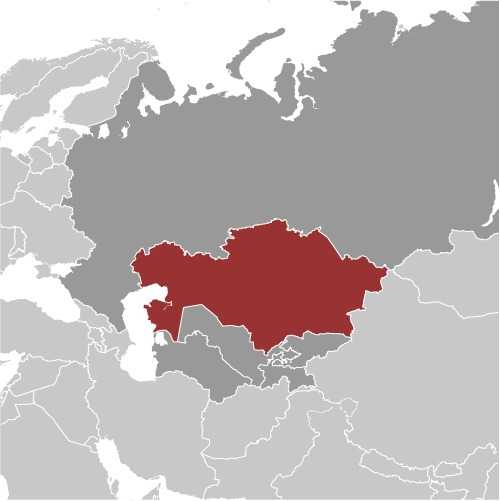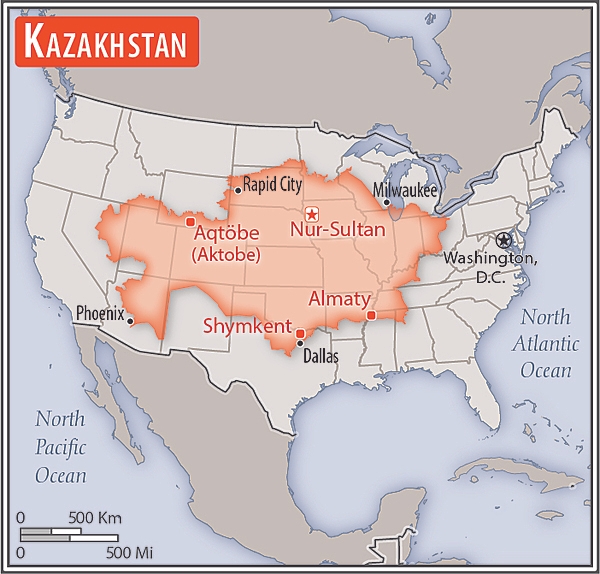Introduction
Background
Ethnic Kazakhs derive from a mix of Turkic nomadic tribes that migrated to the region in the 15th century. The Russian Empire conquered the Kazakh steppe in the 18th and 19th centuries, and Kazakhstan became a Soviet Republic in 1925. Forced agricultural collectivization led to repression and starvation, resulting in more than a million deaths in the early 1930s. During the 1950s and 1960s, the agricultural "Virgin Lands" program generated an influx of settlers -- mostly ethnic Russians, but also other nationalities -- and by the time of Kazakhstan’s independence in 1991, ethnic Kazakhs were a minority. However, non-Muslim ethnic minorities departed Kazakhstan in large numbers from the mid-1990s through the mid-2000s, and a national program has repatriated about a million ethnic Kazakhs (from Uzbekistan, Tajikistan, Mongolia, and the Xinjiang region of China) to Kazakhstan. As a result of this shift, the ethnic Kazakh share of the population now exceeds two-thirds.
Kazakhstan's economy is the largest in Central Asia, mainly due to the country's vast natural resources. Current issues include diversifying the economy, attracting foreign direct investment, enhancing Kazakhstan's economic competitiveness, and strengthening economic relations with neighboring states and foreign powers.
Visit the Definitions and Notes page to view a description of each topic.
Geography
Location
Central Asia, northwest of China; a small portion west of the Ural (Oral) River in easternmost Europe
Geographic coordinates
48 00 N, 68 00 E
Map references
Asia
Land boundaries
total: 13,364 km
border countries (5): China 1,765 km; Kyrgyzstan 1,212 km; Russia 7,644 km; Turkmenistan 413 km; Uzbekistan 2,330 km
Coastline
0 km (landlocked); note - Kazakhstan borders the Aral Sea, now split into two bodies of water (1,070 km), and the Caspian Sea (1,894 km)
Maritime claims
none (landlocked)
Climate
continental, cold winters and hot summers, arid and semiarid
Terrain
vast flat steppe extending from the Volga in the west to the Altai Mountains in the east and from the plains of western Siberia in the north to oases and deserts of Central Asia in the south
Elevation
highest point: Pik Khan-Tengri 7,010 m
note - the northern most 7,000 meter peak in the World
lowest point: Qauyndy Oyysy -132 m
mean elevation: 387 m
Natural resources
major deposits of petroleum, natural gas, coal, iron ore, manganese, chrome ore, nickel, cobalt, copper, molybdenum, lead, zinc, bauxite, gold, uranium
Land use
agricultural land: 77.4% (2018 est.)
arable land: 8.9% (2018 est.)
permanent crops: 0% (2018 est.)
permanent pasture: 68.5% (2018 est.)
forest: 1.2% (2018 est.)
other: 21.4% (2018 est.)
Irrigated land
18,099 sq km (2020)
Major lakes (area sq km)
fresh water lake(s): Ozero Balkhash - 22,000 sq km; Ozero Zaysan - 1,800 sq km
salt water lake(s): Caspian Sea (shared with Iran, Azerbaijan, Turkmenistan, and Russia) - 374,000 sq km; Aral Sea (north) - 3,300 sq km; Ozero Alakol - 2,650 sq km; Ozero Teniz 1,590 sq km; Ozero Seletytenzi - 780 sq km; Ozero Sasykkol - 740 sq km
Major rivers (by length in km)
Syr Darya river mouth (shared with Kyrgyzstan [s], Uzbekistan, and Tajikistan) - 3,078 km
note – [s] after country name indicates river source; [m] after country name indicates river mouth
Major watersheds (area sq km)
Internal (endorheic basin) drainage: Tarim Basin (1,152,448 sq km), Amu Darya (534,739 sq km), Syr Darya (782,617 sq km), Lake Balkash (510,015 sq km)
Population distribution
most of the country displays a low population density, particularly the interior; population clusters appear in urban agglomerations in the far northern and southern portions of the country
Natural hazards
earthquakes in the south; mudslides around Almaty
Geography - note
world's largest landlocked country and one of only two landlocked countries in the world that extends into two continents (the other is Azerbaijan); Russia leases approximately 6,000 sq km of territory enclosing the Baikonur Cosmodrome; in January 2004, Kazakhstan and Russia extended the lease to 2050
People and Society
Population
total: 20,260,006
male: 9,817,172
female: 10,442,834 (2024 est.)
comparison rankings: female 63; male 64; total 64
Nationality
noun: Kazakhstani(s)
adjective: Kazakhstani
Ethnic groups
Kazakh 71%, Russian 14.9%, Uzbek 3.3%, Ukrainian 1.9%, Uyghurs 1.5%, German 1.1%, Tatar 1.1%, other 4.9%, unspecified 0.3% (2023 est.)
Languages
Kazakh (official, Qazaq) 80.1% (understand spoken language), Russian (understand spoken language) 83.7%, English (understand spoken language) 35.1% (2021 est.)
major-language sample(s):
Әлемдік деректер кітабы, негізгі ақпараттың таптырмайтын көзі. (Kazakh)
Книга фактов о мире – незаменимый источник базовой информации. (Russian)
The World Factbook, the indispensable source for basic information.
Religions
Muslim 69.3%, Christian 17.2% (Orthodox 17%, other 0.2%), Buddhism 0.1%, other 0.1%, non-believers 2.3%, unspecified 11% (2021 est.)
Demographic profile
Nearly 40% of Kazakhstan’s population is under the age of 25. Like many former Soviet states, Kazakhstan’s total fertility rate (TFR) – the average number of births per woman – decreased after independence amidst economic problems and fell below replacement level, 2.1. However, in the late 2000s, as the economy improved and incomes rose, Kazakhstan experienced a small baby boom and TFR reached 2.5. TFR has since fallen and is now just over 2.1. Mortality rates are also decreasing and life expectancy is rising, signs that Kazakhstan’s demographic transition is progressing.
Kazakhstan has a diverse population consisting of Asian ethnic groups (predominantly Kazakhs, as well as Uzbeks, Uighurs, and Tatars) and ethnic Europeans (mainly Russians but also Ukrainians and Germans). Approximately two thirds of Kazakhstan’s population today is Kazakh. During the mid-20th century, as Kazakhstan industrialized, waves of ethnic Russians and deportees from other parts of the Soviet Union arrived. Eventually, the ethnic Russian population outnumbered the Kazakhs. In the 1990s, following Kazakhstan’s independence, Russian and other ethnic Europeans began emigrating, while some ethnic Kazakhs (referred to as Oralmans) returned to their homeland from neighboring countries, China, and Mongolia. As a result, the country’s ethnic make-up changed, and a Kazakh majority was reestablished.
In recent years, Kazakhstan has shifted from being mainly a migrant-sending country to a migrant-receiving country. Due to its oil-driven economic boom, Kazakhstan has become a more popular destination. The country needs highly skilled workers in the industrial, business, and education sectors and low-skilled labor in agriculture, markets, services, and construction. Kazakhstan is increasingly reliant on migrant workers, primarily from Kyrgyzstan, Tajikistan, and Uzbekistan, to fill its labor shortage. At the same time, highly skilled Kazakhs continue to emigrate, mostly to Russia, seeking higher salaries or further education.
Age structure
0-14 years: 27.6% (male 2,883,200/female 2,712,772)
15-64 years: 62.8% (male 6,233,881/female 6,486,019)
65 years and over: 9.6% (2024 est.) (male 700,091/female 1,244,043)
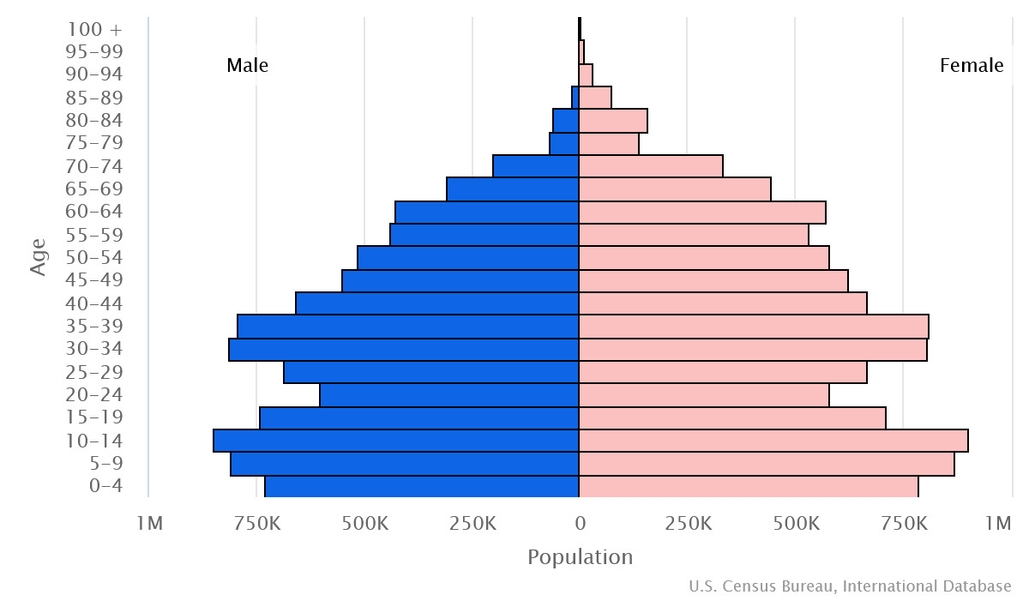
Dependency ratios
total dependency ratio: 60
youth dependency ratio: 47.2
elderly dependency ratio: 12.7
potential support ratio: 7.9 (2021 est.)
Median age
total: 31.9 years (2024 est.)
male: 30 years
female: 33.8 years
comparison ranking: total 121
Population distribution
most of the country displays a low population density, particularly the interior; population clusters appear in urban agglomerations in the far northern and southern portions of the country
Urbanization
urban population: 58.2% of total population (2023)
rate of urbanization: 1.19% annual rate of change (2020-25 est.)
Major urban areas - population
1.987 million Almaty, 1.291 million NUR-SULTAN (capital), 1.155 million Shimkent (2023)
Sex ratio
at birth: 1.07 male(s)/female
0-14 years: 1.06 male(s)/female
15-64 years: 0.96 male(s)/female
65 years and over: 0.56 male(s)/female
total population: 0.94 male(s)/female (2024 est.)
Mother's mean age at first birth
28.9 years (2019 est.)
Infant mortality rate
total: 8 deaths/1,000 live births (2024 est.)
male: 8.9 deaths/1,000 live births
female: 7 deaths/1,000 live births
comparison ranking: total 146
Life expectancy at birth
total population: 73.3 years (2024 est.)
male: 69 years
female: 77.9 years
comparison ranking: total population 151
Gross reproduction rate
1.25 (2024 est.)
Contraceptive prevalence rate
53% (2018)
note: percent of women aged 18-49
Drinking water source
improved: urban: 100% of population
rural: 93.8% of population
total: 97.4% of population
unimproved: urban: 0% of population
rural: 6.2% of population
total: 2.6% of population (2020 est.)
Current health expenditure
3.8% of GDP (2020)
Physicians density
3.98 physicians/1,000 population (2020)
Hospital bed density
6.1 beds/1,000 population (2014)
Sanitation facility access
improved: urban: 99.9% of population
rural: 99.9% of population
total: 99.9% of population
unimproved: urban: 0.1% of population
rural: 0.1% of population
total: 0.1% of population (2020 est.)
Alcohol consumption per capita
total: 3.73 liters of pure alcohol (2019 est.)
beer: 2.52 liters of pure alcohol (2019 est.)
wine: 0.16 liters of pure alcohol (2019 est.)
spirits: 1.05 liters of pure alcohol (2019 est.)
other alcohols: 0 liters of pure alcohol (2019 est.)
comparison ranking: total 100
Tobacco use
total: 23.2% (2020 est.)
male: 39.6% (2020 est.)
female: 6.7% (2020 est.)
comparison ranking: total 63
Currently married women (ages 15-49)
61.8% (2023 est.)
Literacy
definition: age 15 and over can read and write
total population: 99.8%
male: 99.8%
female: 99.7% (2018)
School life expectancy (primary to tertiary education)
total: 16 years
male: 15 years
female: 16 years (2020)
Environment
Environment - current issues
radioactive or toxic chemical sites associated with former defense industries and test ranges scattered throughout the country pose health risks for humans and animals; industrial pollution is severe in some cities; because the two main rivers that flowed into the Aral Sea have been diverted for irrigation, it is drying up and leaving behind a harmful layer of chemical pesticides and natural salts; these substances are then picked up by the wind and blown into noxious dust storms; pollution in the Caspian Sea; desertification; soil pollution from overuse of agricultural chemicals and salination from poor infrastructure and wasteful irrigation practices
Environment - international agreements
party to: Air Pollution, Antarctic Treaty, Biodiversity, Climate Change, Climate Change-Kyoto Protocol, Climate Change-Paris Agreement, Comprehensive Nuclear Test Ban, Desertification, Endangered Species, Environmental Modification, Hazardous Wastes, Ozone Layer Protection, Ship Pollution, Wetlands
signed, but not ratified: none of the selected agreements
Climate
continental, cold winters and hot summers, arid and semiarid
Land use
agricultural land: 77.4% (2018 est.)
arable land: 8.9% (2018 est.)
permanent crops: 0% (2018 est.)
permanent pasture: 68.5% (2018 est.)
forest: 1.2% (2018 est.)
other: 21.4% (2018 est.)
Urbanization
urban population: 58.2% of total population (2023)
rate of urbanization: 1.19% annual rate of change (2020-25 est.)
Air pollutants
particulate matter emissions: 26.5 micrograms per cubic meter (2019 est.)
carbon dioxide emissions: 247.21 megatons (2016 est.)
methane emissions: 45.03 megatons (2020 est.)
Waste and recycling
municipal solid waste generated annually: 4,659,740 tons (2012 est.)
municipal solid waste recycled annually: 136,064 tons (2012 est.)
percent of municipal solid waste recycled: 2.9% (2012 est.)
Major lakes (area sq km)
fresh water lake(s): Ozero Balkhash - 22,000 sq km; Ozero Zaysan - 1,800 sq km
salt water lake(s): Caspian Sea (shared with Iran, Azerbaijan, Turkmenistan, and Russia) - 374,000 sq km; Aral Sea (north) - 3,300 sq km; Ozero Alakol - 2,650 sq km; Ozero Teniz 1,590 sq km; Ozero Seletytenzi - 780 sq km; Ozero Sasykkol - 740 sq km
Major rivers (by length in km)
Syr Darya river mouth (shared with Kyrgyzstan [s], Uzbekistan, and Tajikistan) - 3,078 km
note – [s] after country name indicates river source; [m] after country name indicates river mouth
Major watersheds (area sq km)
Internal (endorheic basin) drainage: Tarim Basin (1,152,448 sq km), Amu Darya (534,739 sq km), Syr Darya (782,617 sq km), Lake Balkash (510,015 sq km)
Total water withdrawal
municipal: 4.62 billion cubic meters (2020 est.)
industrial: 4.54 billion cubic meters (2020 est.)
agricultural: 15.4 billion cubic meters (2020 est.)
Total renewable water resources
108.41 billion cubic meters (2020 est.)
Government
Country name
conventional long form: Republic of Kazakhstan
conventional short form: Kazakhstan
local long form: Qazaqstan Respublikasy
local short form: Qazaqstan
former: Kazakh Soviet Socialist Republic
etymology: the name "Kazakh" may derive from the Turkic word "kaz" meaning "to wander," recalling the Kazakh's nomadic lifestyle; the Persian suffix "-stan" means "place of" or "country," so the word Kazakhstan literally means "Land of the Wanderers"
Government type
presidential republic
Capital
name: Astana
geographic coordinates: 51 10 N, 71 25 E
time difference: UTC+5 (10 hours ahead of Washington, DC, during Standard Time)
time zone note: On 1 March 2024, Kazakhstan moved from two time zones to using one time zone
etymology: the name means "capital city" in Kazakh
note: on 17 September 2022, Kazakhstan changed the name of its capital city from Nur-Sultan back to Astana; this was not the first time the city had its name changed; founded in 1830 as Akmoly, it became Akmolinsk in 1832, Tselinograd in 1961, Akmola (Aqmola) in 1992, Astana in 1998, and Nur-Sultan in 2019; the latest name change occurred just three and a half years after the city was renamed to honor a long-serving (28-year) former president, who subsequently fell out of favor
Administrative divisions
17 provinces (oblystar, singular - oblys) and 4 cities* (qalalar, singular - qala); Abay (Semey), Almaty (Qonaev), Almaty*, Aqmola (Kokshetau), Aqtobe, Astana*, Atyrau, Batys Qazaqstan [West Kazakhstan] (Oral), Bayqongyr*, Mangghystau (Aqtau), Pavlodar, Qaraghandy, Qostanay, Qyzylorda, Shyghys Qazaqstan [East Kazakhstan] (Oskemen), Shymkent*, Soltustik Qazaqstan [North Kazakhstan] (Petropavl), Turkistan, Ulytau (Zhezqazghan), Zhambyl (Taraz), Zhetisu (Taldyqorghan)
note: administrative divisions have the same names as their administrative centers (exceptions have the administrative center name following in parentheses); in 1995, the Governments of Kazakhstan and Russia entered into an agreement whereby Russia would lease for a period of 20 years an area of 6,000 sq km enclosing the Baikonur space launch facilities and the city of Bayqongyr (Baikonur, formerly Leninsk); in 2004, a new agreement extended the lease to 2050
Independence
16 December 1991 (from the Soviet Union)
National holiday
Independence Day, 16 December (1991)
Constitution
history: previous 1937, 1978 (preindependence), 1993; latest approved by referendum 30 August 1995, effective 5 September 1995
amendments: introduced by a referendum initiated by the president of the republic, on the recommendation of Parliament, or by the government; the president has the option of submitting draft amendments to Parliament or directly to a referendum; passage of amendments by Parliament requires four-fifths majority vote of both houses and the signature of the president; passage by referendum requires absolute majority vote by more than one half of the voters in at least two thirds of the oblasts, major cities, and the capital, followed by the signature of the president; amended several times, last in 2022
Legal system
civil law system influenced by Roman-Germanic law and by the theory and practice of the Russian Federation
International law organization participation
has not submitted an ICJ jurisdiction declaration; non-party state to the ICCt
Citizenship
citizenship by birth: no
citizenship by descent only: at least one parent must be a citizen of Kazakhstan
dual citizenship recognized: no
residency requirement for naturalization: 5 years
Suffrage
18 years of age; universal
Executive branch
chief of state: President Kasym-Zhomart TOKAYEV (since 20 March 2019)
head of government: Prime Minister Olzhas BEKTENOV (since 6 February 2024); note - Alikhan SMAILOV resigned on 5 February 2024
cabinet: the president appoints ministers based on the prime minister's recommendations; the president has veto power over all appointments and independently appoints the ministers of defense, internal affairs, and foreign affairs
elections/appointments: president directly elected by simple majority popular vote for a single 7-year term (prior to September 2022, the president of Kazakhstan could serve up to two 5-year terms; legislation passed in September 2022 reduced the maximum number of terms to one 7-year term); election last held on 20 November 2022 (next to be held in 2029); prime minister and deputy prime ministers appointed by the president, approved by the Mazhilis
election results: 2024: Olzhas BEKTENOV elected as prime minister; 69-0 in parliament
2022: Kasym-Zhomart TOKAYEV reelected president; percent of vote - Kassym-Jomart TOKAYEV (Amanat) 81.3%, Zhiguli DAYRABAEV (Auyl) 3.4%, Qaraqat or Karakat ÄBDEN (KÄQŪA) 2.6%, Meyram KAZHYKEN (Amanat) 2.5%, Nurlan AUYESBAYEV (NSDP) 2.2%, Saltanat TURSYNBEKOVA (QA-DJ) 2.1%, other 5.8%
2019: Kasym-Zhomart TOKAYEV elected president; percent of vote - Kasym-Zhomart TOKAYEV (Amanat) 71%, Amirzhan KOSANOV (Ult Tagdyry) 16.2%, Daniya YESPAYEVA (Ak Zhol) 5.1%, other 7.7%
Legislative branch
description: bicameral Parliament of the Republic of Kazakhstan consists of:
Senate (50 seats); 40 members indirectly elected by 2-round majority vote by the oblast-level assemblies and 10 members appointed by decree of the president; members serve 6-year terms, with one-half of the membership renewed every 3 years)
Mazhilis (98 seats; 69 members directly elected in a single national constituency by party list proportional representation vote (5% minimum threshold to gain seats) and 29 directly elected in single-seat constituencies to serve 5-year terms
elections: Senate - last held on 14 January 2023 (next to be held in 2026)
Mazhilis - last held on 19 March 2023 (next to be held in 2026)
election results: Senate - percent of vote by party - NA; seats by party - NA; composition - men 38, women 12, percentage women 24%
Mazhilis - percent of vote by party - Nur Otan 53.9%, Auvl 10.9%, Respublica 8.6%, Ak Zhol 8.4%, QHP 6.8%, NSDP 5.2%, Baytak 2.3%, Against all 3.9%; percent of vote by party (single-mandate districts) - Nur Otan 75.9%, independent 24%; seats by party - Nur Otan 62, Auvl 8, Respublica 6, Ak Zhol 6, QHP 5, NSDP 4, independent 7; composition - men 79, women 19, percentage women 18.4%; note - total Parliament percentage women 20.9%
Judicial branch
highest court(s): Supreme Court of the Republic (consists of 44 members); Constitutional Council (consists of the chairperson and 6 members)
judge selection and term of office: Supreme Court judges proposed by the president of the republic on recommendation of the Supreme Judicial Council and confirmed by the Senate; judges normally serve until age 65 but can be extended to age 70; Constitutional Council - the president of the republic, the Senate chairperson, and the Mazhilis chairperson each appoints 2 members for a 6-year term; chairperson of the Constitutional Council appointed by the president for a 6-year term
subordinate courts: regional and local courts
Political parties and leaders
Ak Zhol (Bright Path) Party or Democratic Party of Kazakhstan Ak Zhol [Azat PERUASHEV]
Amanat Party [Yerlan KOSHANOV] (formerly Nur Otan (Radiant Fatherland))
Baytak (Boundless) Party [Azamatkhan AMIRTAY]
National Social Democratic Party or NSDP [Askhat RAKHIMZHANOV]
People's Democratic (Patriotic) Party or Auyl or AHDPP [Ali BEKTAYEV]
People's Party of Kazakhstan or QHP [Yermkhamet YERTYSBAYEV]
Respublica Party [Avdarbek KHODZHANAZAROV]
International organization participation
ADB, CICA, CIS, CSTO, EAEU, EAPC, EBRD, ECO, EITI (compliant country), FAO, GCTU, IAEA, IBRD, ICAO, ICC (NGOs), ICRM, IDA, IDB, IFAD, IFC, IFRCS, ILO, IMF, IMO, Interpol, IOC, IOM, IPU, ISO, ITSO, ITU, MIGA, MINURSO, NAM (observer), NSG, OAS (observer), OIC, OPCW, OSCE, PFP, SCO, UN, UNCTAD, UNESCO, UNHRC, UNIDO, UN Security Council (temporary), UNWTO, UPU, WCO, WFTU (NGOs), WHO, WIPO, WMO, WTO, ZC
Diplomatic representation in the US
chief of mission: Ambassador Yerzhan ASHIKBAYEV (since 7 July 2021)
chancery: 1401 16th Street NW, Washington, DC 20036
telephone: [1] (202) 232-5488
FAX: [1] (202) 232-5845
email address and website:
washington@mfa.kz
https://www.gov.kz/memleket/entities/mfa-washington?lang=en
consulate(s) general: New York, San Francisco
Diplomatic representation from the US
chief of mission: Ambassador Daniel N. ROSENBLUM (since 14 November 2022)
embassy: Rakhymzhan Koshkarbayev Avenue, No. 3, Astana 010010
mailing address: 2230 Astana Place, Washington DC 20521-2230
telephone: [7] (7172) 70-21-00
FAX: [7] (7172) 54-09-14
email address and website:
USAKZ@state.gov
https://kz.usembassy.gov/
consulate(s) general: Almaty
Flag description
a gold sun with 32 rays above a soaring golden steppe eagle, both centered on a sky blue background; the hoist side displays a national ornamental pattern "koshkar-muiz" (the horns of the ram) in gold; the blue color is of religious significance to the Turkic peoples of the country, and so symbolizes cultural and ethnic unity; it also represents the endless sky as well as water; the sun, a source of life and energy, exemplifies wealth and plenitude; the sun's rays are shaped like grain, which is the basis of abundance and prosperity; the eagle has appeared on the flags of Kazakh tribes for centuries and represents freedom, power, and the flight to the future
National symbol(s)
golden eagle; national colors: blue, yellow
National anthem
name: "Menin Qazaqstanim" (My Kazakhstan)
lyrics/music: Zhumeken NAZHIMEDENOV and Nursultan NAZARBAYEV/Shamshi KALDAYAKOV
note: adopted 2006; President Nursultan NAZARBAYEV played a role in revising the lyrics
National heritage
total World Heritage Sites: 6 (3 cultural, 3 natural)
selected World Heritage Site locales: Mausoleum of Khoja Ahmed Yasawi (c); Petroglyphs at Tanbaly (c); Saryarka - Steppe and Lakes of Northern Kazakhstan (n); Silk Roads: the Chang'an-Tianshan Corridor (c); Western Tien-Shan (n); Cold Winter Deserts of Turan (n)
Economy
Economic overview
oil and gas giant, with growing international investment; domestic economy hit hard by COVID-19 disruptions; reforming civil society and improving business confidence; legacy state controls and Russian influence inhibit growth and autonomy
Real GDP (purchasing power parity)
$512.002 billion (2022 est.)
$496.126 billion (2021 est.)
$475.672 billion (2020 est.)
note: data in 2017 dollars
comparison ranking: 41
Real GDP growth rate
3.2% (2022 est.)
4.3% (2021 est.)
-2.5% (2020 est.)
note: annual GDP % growth based on constant local currency
comparison ranking: 131
Real GDP per capita
$26,100 (2022 est.)
$26,100 (2021 est.)
$25,400 (2020 est.)
note: data in 2017 dollars
comparison ranking: 78
GDP (official exchange rate)
$225.496 billion (2022 est.)
note: data in current dollars at official exchange rate
Inflation rate (consumer prices)
8.04% (2021 est.)
6.77% (2020 est.)
5.25% (2019 est.)
note: annual % change based on consumer prices
comparison ranking: 130
Credit ratings
Fitch rating: BBB (2016)
Moody's rating: Baa3 (2016)
Standard & Poors rating: BBB- (2016)
note: The year refers to the year in which the current credit rating was first obtained.
GDP - composition, by sector of origin
agriculture: 4.7% (2017 est.)
industry: 34.1% (2017 est.)
services: 61.2% (2017 est.)
comparison rankings: services 112; industry 49; agriculture 128
GDP - composition, by end use
household consumption: 53.2% (2017 est.)
government consumption: 11.1% (2017 est.)
investment in fixed capital: 22.5% (2017 est.)
investment in inventories: 4.8% (2017 est.)
exports of goods and services: 35.4% (2017 est.)
imports of goods and services: -27.1% (2017 est.)
Agricultural products
wheat, milk, potatoes, barley, watermelons, sunflower seeds, cantaloupes/melons, onions, maize, linseed (2022)
note: top ten agricultural products based on tonnage
Industries
oil, coal, iron ore, manganese, chromite, lead, zinc, copper, titanium, bauxite, gold, silver, phosphates, sulfur, uranium, iron and steel; tractors and other agricultural machinery, electric motors, construction materials
Industrial production growth rate
4.15% (2022 est.)
note: annual % change in industrial value added based on constant local currency
comparison ranking: 93
Labor force
9.481 million (2022 est.)
note: number of people ages 15 or older who are employed or seeking work
comparison ranking: 57
Unemployment rate
4.86% (2022 est.)
5.57% (2021 est.)
4.89% (2020 est.)
note: % of labor force seeking employment
comparison ranking: 98
Youth unemployment rate (ages 15-24)
total: 3.7% (2021 est.)
male: 3.3%
female: 4.3%
comparison ranking: total 194
Population below poverty line
5.2% (2022 est.)
note: % of population with income below national poverty line
Gini Index coefficient - distribution of family income
27.8 (2018 est.)
note: index (0-100) of income distribution; higher values represent greater inequality
comparison ranking: 162
Average household expenditures
on food: 44.9% of household expenditures (2018 est.)
on alcohol and tobacco: 1.7% of household expenditures (2018 est.)
Household income or consumption by percentage share
lowest 10%: 4.3%
highest 10%: 23.4% (2018 est.)
note: % share of income accruing to lowest and highest 10% of population
Remittances
0.21% of GDP (2022 est.)
0.16% of GDP (2021 est.)
0.22% of GDP (2020 est.)
note: personal transfers and compensation between resident and non-resident individuals/households/entities
Budget
revenues: $29.955 billion (2020 est.)
expenditures: $41.994 billion (2020 est.)
Public debt
22.41% of GDP (2021 est.)
23.72% of GDP (2020 est.)
18.48% of GDP (2019 est.)
note: central government debt as a % of GDP
comparison ranking: 181
Taxes and other revenues
9.45% (of GDP) (2021 est.)
note: central government tax revenue as a % of GDP
comparison ranking: 191
Fiscal year
calendar year
Current account balance
$7.079 billion (2022 est.)
-$2.672 billion (2021 est.)
-$10.96 billion (2020 est.)
note: balance of payments - net trade and primary/secondary income in current dollars
comparison ranking: 30
Exports
$93.581 billion (2022 est.)
$71.726 billion (2021 est.)
$49.273 billion (2020 est.)
note: balance of payments - exports of goods and services in current dollars
comparison ranking: 52
Exports - partners
China 14%, Italy 13%, Russia 9%, UK 8%, Netherlands 6% (2022)
note: top five export partners based on percentage share of exports
Exports - commodities
crude petroleum, gold, refined copper, iron alloys, radioactive chemicals (2022)
note: top five export commodities based on value in dollars
Imports
$60.147 billion (2022 est.)
$49.597 billion (2021 est.)
$46.502 billion (2020 est.)
note: balance of payments - imports of goods and services in current dollars
comparison ranking: 63
Imports - partners
Russia 29%, China 28%, Germany 5%, South Korea 4%, Turkey 3% (2022)
note: top five import partners based on percentage share of imports
Imports - commodities
garments, cars, broadcasting equipment, plastic products, packaged medicine (2022)
note: top five import commodities based on value in dollars
Reserves of foreign exchange and gold
$35.076 billion (2022 est.)
$34.378 billion (2021 est.)
$35.638 billion (2020 est.)
note: holdings of gold (year-end prices)/foreign exchange/special drawing rights in current dollars
comparison ranking: 54
Exchange rates
tenge (KZT) per US dollar -
Exchange rates:
460.165 (2022 est.)
425.908 (2021 est.)
412.953 (2020 est.)
382.747 (2019 est.)
344.706 (2018 est.)
Energy
Electricity access
electrification - total population: 100% (2021)
Electricity
installed generating capacity: 25.022 million kW (2020 est.)
consumption: 92,133,960,000 kWh (2019 est.)
exports: 2.419 billion kWh (2019 est.)
imports: 1.935 billion kWh (2019 est.)
transmission/distribution losses: 9.689 billion kWh (2019 est.)
comparison rankings: installed generating capacity 40; transmission/distribution losses 180; imports 57; exports 48; consumption 34
Electricity generation sources
fossil fuels: 88.2% of total installed capacity (2020 est.)
nuclear: 0% of total installed capacity (2020 est.)
solar: 0.9% of total installed capacity (2020 est.)
wind: 0.7% of total installed capacity (2020 est.)
hydroelectricity: 10.1% of total installed capacity (2020 est.)
tide and wave: 0% of total installed capacity (2020 est.)
geothermal: 0% of total installed capacity (2020 est.)
biomass and waste: 0% of total installed capacity (2020 est.)
Nuclear energy
Number of operational nuclear reactors: 0
Number of nuclear reactors under construction: 0
Net capacity of operational nuclear reactors: 0GW
Percent of total electricity production: 0%
Percent of total energy produced: 0%
Number of nuclear reactors permanently shut down: 1
Coal
production: 102.338 million metric tons (2020 est.)
consumption: 74.819 million metric tons (2020 est.)
exports: 3.002 million metric tons (2020 est.)
imports: 993,000 metric tons (2020 est.)
proven reserves: 25.605 billion metric tons (2019 est.)
Petroleum
total petroleum production: 1,864,900 bbl/day (2021 est.)
refined petroleum consumption: 320,600 bbl/day (2019 est.)
crude oil and lease condensate exports: 1,531,600 bbl/day (2018 est.)
crude oil and lease condensate imports: 500 bbl/day (2018 est.)
crude oil estimated reserves: 30 billion barrels (2021 est.)
Natural gas
production: 25.786 billion cubic meters (2019 est.)
consumption: 14.557 billion cubic meters (2019 est.)
exports: 16.418 billion cubic meters (2019 est.)
imports: 7.714 billion cubic meters (2019 est.)
proven reserves: 2.407 trillion cubic meters (2021 est.)
Carbon dioxide emissions
263.689 million metric tonnes of CO2 (2019 est.)
from coal and metallurgical coke: 195.926 million metric tonnes of CO2 (2019 est.)
from petroleum and other liquids: 39.205 million metric tonnes of CO2 (2019 est.)
from consumed natural gas: 28.557 million metric tonnes of CO2 (2019 est.)
comparison ranking: total emissions 25
Communications
Telephones - fixed lines
total subscriptions: 2,887,900 (2022 est.)
subscriptions per 100 inhabitants: 16 (2021 est.)
comparison ranking: total subscriptions 40
Telephones - mobile cellular
total subscriptions: 24.323 million (2021 est.)
subscriptions per 100 inhabitants: 127 (2021 est.)
comparison ranking: total subscriptions 53
Telecommunication systems
general assessment: Kazakhstan has one of the most developed telecommunications sectors in the Central Asian region; this is especially true of the mobile segment; the principal telcos have successfully generated revenue growth on the back of value-added services and the extended each of LTE and fiber networks; this has resulted in strong growth in mobile fixed line traffic; the mobile segment dominates the telecom sector in Kazakhstan overall, there was a drop in the number of subscribers in 2020; these effects also limited growth in 2021, though the easing of restrictions in 2022 resulted in a stronger recovery; the extensive deployment of LTE networks across the country, and the launch of limited 5G services in mid-2023 will provide a steady increase mobile broadband services (2021)
domestic: fixed telephone subscriptions are 16 per 100 persons; mobile-cellular subscriber base 127 per 100 persons (2021)
international: country code - 7; international traffic with other former Soviet republics and China carried by landline and microwave radio relay and with other countries by satellite and by the TAE fiber-optic cable; satellite earth stations - 2 Intelsat
Broadcast media
the state owns nearly all radio and TV transmission facilities and operates national TV and radio networks; there are 96 TV channels, many of which are owned by the government, and 4 state-run radio stations; some former state-owned media outlets have been privatized; households with satellite dishes have access to foreign media; a small number of commercial radio stations operate along with state-run radio stations; recent legislation requires all media outlets to register with the government and all TV providers to broadcast in digital format by 2018; broadcasts reach some 99% of the population as well as neighboring countries (2018)
Internet users
total: 17.29 million (2021 est.)
percent of population: 91% (2021 est.)
comparison ranking: total 45
Broadband - fixed subscriptions
total: 2,620,400 (2020 est.)
subscriptions per 100 inhabitants: 14 (2020 est.)
comparison ranking: total 48
Transportation
National air transport system
number of registered air carriers: 12 (2020)
inventory of registered aircraft operated by air carriers: 84
annual passenger traffic on registered air carriers: 7,143,797 (2018)
annual freight traffic on registered air carriers: 50.22 million (2018) mt-km
Heliports
30 (2024)
Pipelines
658 km condensate, 15,429 km gas (2020), 8,020 km oil (2020), 1,095 km refined products, 1,975 km water (2017) (2020)
Railways
total: 16,636 km (2021)
broad gauge: 16,636 km (2021) 1.520-m gauge (4,237 km electrified)
comparison ranking: total 17
Waterways
43,983 km (2020) (on the Ertis (Irtysh) River (80%) and Syr Darya (Syrdariya) River)
comparison ranking: 4
Merchant marine
total: 122 (2023)
by type: general cargo 3, oil tanker 7, other 112
comparison ranking: total 82
Ports and terminals
major seaport(s): Caspian Sea - Aqtau (Shevchenko), Atyrau (Gur'yev)
river port(s): Oskemen (Ust-Kamenogorsk), Pavlodar, Semey (Semipalatinsk) (Irtysh River)
Military and Security
Military and security forces
Armed Forces of the Republic of Kazakhstan: Land Forces, Naval Forces, Air and Air Defense Forces
Ministry of Internal Affairs: National Police, National Guard
Committee for National Security (KNB): Border Guard Service (2024)
note: the National Guard is a gendarmerie type force administered by the Ministry of Internal Affairs, but also serves the Ministry of Defense; it is responsible for fighting crime, maintaining public order, and ensuring public safety; other duties include anti-terrorism operations, guarding prisons, riot control, and territorial defense in time of war
Military expenditures
0.7% of GDP (2022 est.)
1% of GDP (2021 est.)
1.1% of GDP (2020 est.)
1.1% of GDP (2019 est.)
0.9% of GDP (2018 est.)
comparison ranking: 147
Military and security service personnel strengths
information varies; approximately 40,000 active-duty personnel (25,000 Land Forces; 3,000 Naval Forces; 12,000 Air and Air Defense Forces); approximately 30,000 National Guard (2023)
Military equipment inventories and acquisitions
the Kazakh military's inventory is comprised of mostly older Russian and Soviet-era equipment, and Russia continues to be the leading supplier of arms (2023)
Military service age and obligation
all men 18-27 are required to serve in the military for 12-24 months; women may volunteer (2023)
note: as of 2022, more than 10,000 women served in the Armed Forces and the National Guard
Military - note
Kazakhstan’s armed forces were formed in 1992 following the breakup of the Soviet Union and the disbandment of the Soviet Turkestan Military District whose forces formed the core of the new Kazakh military; the military’s principal responsibilities are territorial defense while the National Police, National Guard, Committee for National Security, and Border Service have primary responsibility for internal security, although the military may provide assistance as required; the military also participates in humanitarian and peacekeeping operations; in 2008, Kazakhstan opened up Central Asia’s first peacekeeper training center for military personnel of Kazakhstan, NATO, and other partners
in 2022, Kazakhstan initiated a wide-ranging effort to enhance the country’s security sector, including organizational changes such as establishing new National Guard units, enhancing existing ones, and forming a special operations force, spending increases for equipment acquisitions, a new doctrine with renewed emphasis on defense of the border, and reforms to improve professionalism in the military
the Land Forces are organized into combat brigades of air assault and mechanized infantry, tank, artillery, and surface-to-surface missile forces; the Naval Forces include a naval infantry brigade and patrol craft for operating on the Caspian Sea; the Air Defense Forces have over 100 combat aircraft, largely of Soviet-origin; the National Guard is organized into regions and deployed throughout the country
Kazakhstan has been a member of the Collective Security Treaty Organization (CSTO) since 1994 and has obligated troops to CSTO's rapid reaction force; it also has a relationship with NATO focused on democratic, institutional, and defense reforms; relations with NATO started in 1992, and Kazakhstan joined NATO's Partnership for Peace program in 1995 (2023)
Space
Space agency/agencies
National Space Agency of the Republic of Kazakhstan (KazCosmos; established 2007) (2023)
Space launch site(s)
Baikonur Cosmodrome/Space Center (Baikonur; the cosmodrome and the surrounding area are leased and administered by Russia until 2050 for approximately $115 million/year; Baikonur cosmodrome was originally built by the Soviet Union in the mid-1950s; largest space launch facility in the World and site of the World’s first successful satellite launch in 1957); note – in 2018, Kazakhstan and Russia agreed that Kazakhstan would build, maintain, and operate a new space launch facility (Baiterek) at the Baikonur space center (estimated to be ready for operations in 2024) (2023)
Space program overview
has an active and ambitious space program that originated with the former Soviet Union; focused on the acquisition and operation of satellites; builds (with foreign assistance) and operates communications, remote sensing (RS), and scientific satellites; building space infrastructure, such as launch and testing facilities, ground stations, and rocket manufacturing; has an astronaut (cosmonaut) program; has relations with a variety of foreign space agencies and industries, including those of China, France, Germany, India, Israel, Italy, Japan, Russia, Saudi Arabia, Sweden, Thailand, Turkey, Ukraine, UAE, and the UK; has state-owned and private companies that assist in the development and building of the country’s space program, including satellites, satellite payloads, and associated capabilities; they also work closely with foreign commercial entities (2023)
note: further details about the key activities, programs, and milestones of the country’s space program, as well as government spending estimates on the space sector, appear in Appendix S
Transnational Issues
Refugees and internally displaced persons
stateless persons: 7,558 (2022)
Illicit drugs
part of the "Northern Route," land drug trafficking route from Afghanistan to Russia and Europe; domestic manufacturing of synthetics increasing and domestic drug use trends to synthetic drugs outpacing heroin and cannabis;
